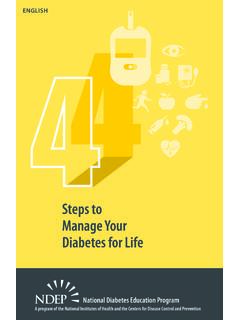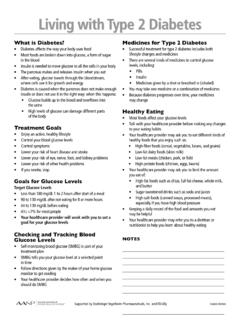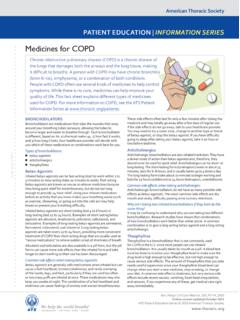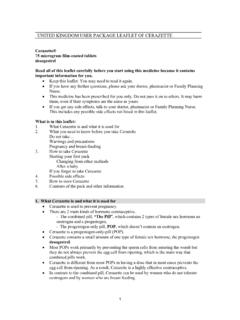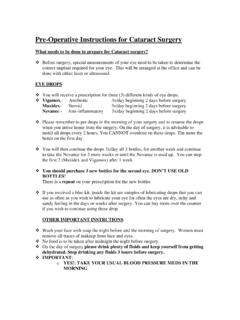Transcription of Tasty Recipes for People with Diabetes and Their Families
1 For People with Diabetes and Their Families March 2011 CS115685 NDEP-51 The Department of Health and Human Services National Diabetes Education Program is jointly sponsored by the National Institutes of Health and the Centers for Disease Control and Prevention with the support of more than 200 partner organizations. 2 Recipe Booklet What is Diabetes ? Diabetes means that your blood glucose ( blood sugar) is too high. Glucose comes from the food we eat. An organ called the pancreas (PAN-kree-as) makes insulin (IN-suh-lin). Insulin helps glucose get from your blood into your cells. Cells take the glucose and turn it into energy. When you have Diabetes , your body has a problem making or properly using insulin.
2 As a result, glucose builds up in your blood and cannot get into your cells. If the blood glucose stays too high, it can damage your body. What are the symptoms of Diabetes ? Common symptoms of Diabetes include: Having to urinate often. Being very thirsty. Feeling very hungry or tired. Losing weight without trying. But many People with Diabetes have no symptoms at all. Why should I be concerned about Diabetes ? Diabetes is a very serious disease. Do not be misled by phrases that suggest Diabetes is not a serious disease, such as a touch of sugar, borderline Diabetes , or my blood glucose is a little bit high. Diabetes can lead to other serious health problems. When high levels of glucose in the blood are not controlled, they can slowly damage your eyes, heart, kidneys, nerves, and feet.
3 What are the types of Diabetes ? There are three main types of Diabetes . Type 1 Diabetes In this type of Diabetes , the body does not make insulin. People with type 1 Diabetes need to take insulin every day. Type 2 Diabetes In this type of Diabetes , the body does not make enough insulin or use insulin well. Some People with type 2 Diabetes have to take Diabetes pills, insulin, or both. Type 2 Diabetes is the most common form of Diabetes . Gestational Diabetes This type of Diabetes can occur when a woman is pregnant. It raises the risk that both she and her child might develop Diabetes later in life. 3 Good news! You can control Diabetes .
4 Diabetes can be managed. You can successfully manage Diabetes and avoid the serious health problems it can cause if you follow these steps: Ask your doctor how you can learn more about your Diabetes to help you feel better today and in the future. Know your Diabetes ABCs (see page 5). Make healthy food choices and be physically active most days. Following this advice will help you keep off extra pounds and will also help keep your blood glucose under control. Check your blood glucose as your doctor tells you to. If you are taking Diabetes medications, take them even if you feel well. To avoid problems with your Diabetes , see your health care team at least twice a year. Finding and treating any problems early will prevent them from getting worse.
5 Ask how Diabetes can affect your eyes, heart, kidneys, nerves, legs, and feet. Be actively involved in your Diabetes care. Work with your health care team to come up with a plan for making healthy food choices and being active a plan that you can stick to. Creating a healthy meal plan. This recipe booklet is a place to start creating healthy meals. Ask your doctor to refer you to a registered dietitian or a Diabetes educator who can help you create a meal plan for you and your family. The dietitian will work with you to come up with a meal plan tailored to your needs. Your meal plan will take into account things like: Your blood glucose levels. Your weight. Medicines you take. Other health problems you have.
6 How physically active you are. Making healthy food choices. Eat smaller portions. Learn what a serving size is for different foods and how many servings you need in a meal. Eat less fat. Choose fewer high-fat foods and use less fat for cooking. You especially want to limit foods that are high in saturated fats or trans fat, such as: Fatty cuts of meat. Whole milk and dairy products made from whole milk. Cakes, candy, cookies, crackers, and pies. Fried foods. Salad dressings. Lard, shortening, stick margarine, and non dairy creamers. 4 Your Diabetes ABCs. A stands for A1C test. This test measures your average blood glucose levels for the past three months. Your doctor should test your A1C at least twice a year.
7 For most People with Diabetes , the goal is to have an A1C score of less than 7. B stands for blood pressure , a measurement of how hard your heart needs to work to keep your blood circulating. For most People with Diabetes , the goal is to keep blood pressure below 130/80. C stands for cholesterol, a fat found in your blood . There are two kinds of cholesterol: LDL, or bad cholesterol, and HDL, or good cholesterol. For most People with Diabetes , the goal is to keep: LDL cholesterol below 100. HDL cholesterol above 40 (HDL for men > 40 and for women > 50). Ask your doctor what you can do to reach your targets for A1C, blood pressure , and cholesterol. 5 Eat more fiber by eating more whole-grain foods.
8 Whole grains can be found in: Breakfast cereals made with 100% whole grains. Oatmeal. Whole grain rice. Whole-wheat bread, bagels, pita bread, and tortillas. Eat a variety of fruits and vegetables every day. Choose fresh, frozen, canned, or dried fruit and 100% fruit juices most of the time. Eat plenty of veggies like these: Dark green veggies ( , broccoli, spinach, brussel sprouts). Orange veggies ( , carrots, sweet potatoes*, pumpkin, winter squash). Beans and peas ( , black beans*, garbanzo beans*, kidney beans*, pinto beans*, split peas*, lentils*). Eat fewer foods that are high in sugar, such as: Fruit-flavored drinks. Sodas. Tea or coffee sweetened with sugar.
9 Use less salt in cooking and at the table. Eat fewer foods that are high in salt, such as: Canned and package soups. Canned vegetables. Pickles. Processed meats. Never skip meals. Stick to your meal plan as best you can. Limit the amount of alcohol you drink. Make changes slowly. It takes time to achieve lasting goals. *Portions of these vegetables count as a bread exchange. (See discussion of Exchange Method below if you are not already familiar with it.) Note: There are several ways to make a Diabetes meal plan. One popular and flexible approach is the Exchange Program method, which provides a quick way to estimate energy, carbohydrates, protein, and fat content in any food or meal.
10 Food from each exchange (starch, meat and meat substitute, fruit, vegetable, milk, and fat) is defined so that one serving of each food contains the same amount of carbohydrate, protein, fat, and energy (calories). Another method is carbohydrate counting. Using this method, you focus on eating a specific number of carbohydrates at specific times of the day. 6 Following a meal plan that is made for you will help you feel better, keep your blood glucose levels in your target range, take in the right amount of calories, and get enough nutrients. Where can you learn more about making a Diabetes meal plan? Contact a registered dietitian to make a meal plan just for you.












